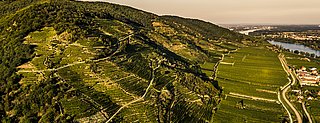
Loibenberg
Facts:
- Town:
- Unterloiben
- Subsites:
- Langen Zung , Süssenberg , Rauheneck , Rothenberg
- Size in ha:
- 35,58
- Altitude in m:
- 212 - 394
- Aspect:
- W - SE
- Average Slope in %:
- 39
- Max. Slope in %:
- 81
- Insolation in hours per year:
- 2004
- Terraced vineyard:
- Yes
- Distance to Danube in m:
- 414
- Labour required in h:
- 26.700
- First documentary evidence:
- 1371
Winery
-

Weingut Alzinger
Dürnstein -

Weingut Bäuerl
Dürnstein -

Weinhauer Brustbauer
Dürnstein -

Domäne Wachau
Dürnstein -

Weingut Martin und Karin Fink
Dürnstein -

Weingut Georg Frischengruber
Rührsdorf -

Weingut Simon Gattinger
Dürnstein -

Emmerich Granner
Dürnstein -

Weingut Hutter
Mautern -

Weingut Knoll
Dürnstein -

Weingut Konrad
Dürnstein -

Winzerhof Leonhartsberger
Dürnstein -

Weingut Schmelz
Joching-Weißenkirchen, Joching -

Weingut Paul Stierschneider - Urbanushof
Dürnstein -

Tegernseerhof
Dürnstein -

Vinotake
Dürnstein
Description
As already suggested by the name, this vineyard is located on the Loibenberg, which shapes the overall appearance of the townscape. The vast extent and great differences in altitude have led to the distinction of a total of 4 official vineyard sections and a multitude of small differences, which local winemakers bring to prominence in maturing. The geology is dominated by Gföhl gneiss, although there are also several parcels where loess patches developed, further emphasising the diversity. The vineyard was documented in 1381, when is was still called "leub_n perig".
Soil Profile Loibenberg
The profile comes from a middle slope on the Loibenberg. The parent rock is Gföhl gneiss, a metamorphic rock that was transformed from an acidic, granitic parent rock.
The sandy and stony soil favours water drainage and facilitates root growth. The soil also warms readily, allowing early budding of the vines in spring.
Erosion on the slope has mixed in glacial, calcareous loess material. In turn, progressive soil development has caused natural decalcification, which is why the topsoil today contains only a few percent carbonate. In contrast, the parent rock still clearly contains secondary carbonates, i.e. precipitates from the soil solution, in the form of coatings and fillings.
